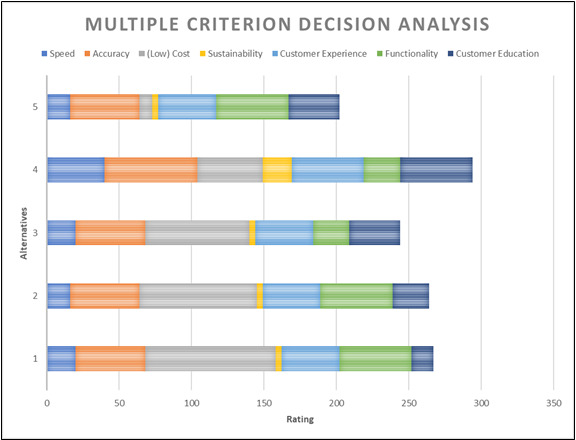Summary of Comparison & Proposed System Summary
Summary of Comparison
The multiple criterion decision analysis shows a relationship between each alternative on a scale of one to ten for each criterion. The criteria were assigned weights by the client and each alternative is rated as detailed in the section titled Comparison Based on Criteria. The rates are multiplied by the weights to get a subtotal for each alternative. The subtotals are then summed, and a final total is determined for each alternative. The alternative with the highest total is the highest-rated solution overall. This solution is shown to be the fittest alternative to solve the root problem as determined by the criteria and assigned weights. Alternative #4: Automatic Technology is shown to have the highest total with 294 and the next closest alternative is Alternative #1: Restructure/Reorganize Efficiency with a total of 267. A full display of the rating and weights for each approved criterion for the selected alternatives is given in Figure 15: MCDA.
A visual representation of Figure 15: Multiple Criterion Decision Analysis can be found in Figure 16: Multiple Criterion Decision Analysis Stacked Bar Diagram which displays a stacked bar diagram of the alternatives and each alternatives’ assigned rating for each criterion.
Systems Analyst Brian Faust Introduces the Proposed Solution
PROPOSED SYSTEM SUMMARY
The alternative that best solves the problem facing the client is Alternative #4: Automatic Technology. The problem is best solved by automatic technologies, including people screening, cabin baggage, automated tray return, explosive trace detectors, and an integrated system. This was chosen because it was rated the highest in three of the seven criteria on the Alternatives Evaluation Matrix. The criteria that this solution excelled in includes speed, accuracy, and customer education. The “state-of-the-art" technology affects the speed of the process. For example, the cabin baggage has a high throughput of 350 passengers per hour. Accuracy is improved upon as well. The cabin baggage screening system has a low false alarm detection rate, which would reduce the number of times TSO have to review flagged carry-ons. Customers would have a better experience in the security process after the implementation of these technologies. Automation allows for a streamlined customer experience that is efficient and easy to understand. Customers will also enjoy a relaxed state of mind knowing that updated technology is used to ensure their safety. The highly-rated functionality of the solution removes tedious job duties from TSO. Automation allows for a reduction of human reliance, which means TSO have less to do with operating equipment and can focus more on ensuring customer satisfaction and security.
This solution is the most optimal for the client because it best solves the issue of keeping both employees and customers physically healthy and mentally calm while maintaining high levels of security. The symptoms of this problem, which include congestion at checkpoints and physical contact between passengers and employees, are also resolved. Alternative #4: Automatic Technology will reduce how long people wait in security lines, allowing customers to move through the lines without creating bottlenecks that reduce “social distancing.” Increasing automation also reduces the need for TSO to conduct pat-downs or luggage searches which can further reduce security line bottlenecks. With this solution, the airport can avoid the extreme congestion that will result from returning passenger levels.
The mental health of customers will also be improved with this solution. Customers that are concerned with Covid-19 are more inclined to fly when a less tangible screening process is put into place. This solution also reduces the need for customers to remove their shoes, belts, and/or jackets, which reduces the stress of not knowing what the procedures are. Customers can also stay mentally calm because there will be fewer concerns about anxiety in large crowds, and fewer crowds mean that the TSA can better socially distance.


